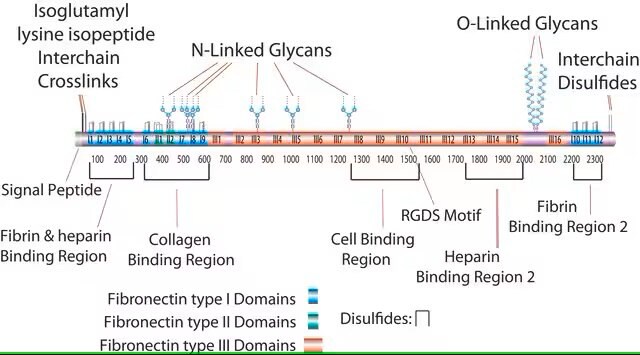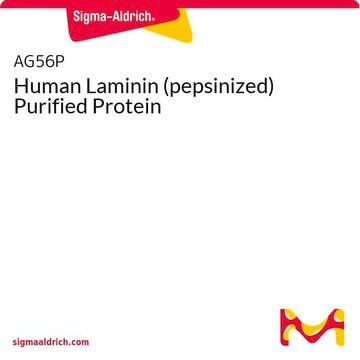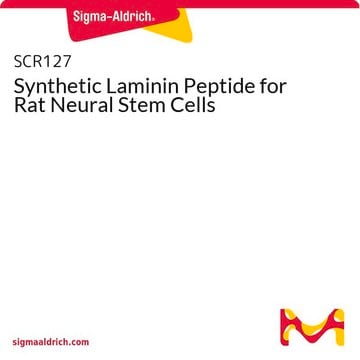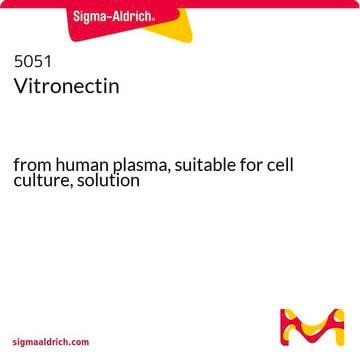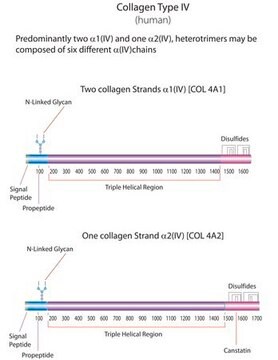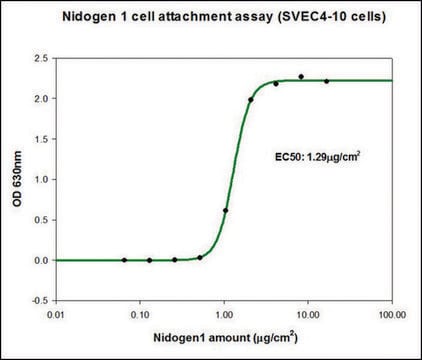It is Laminin-1.
L4544
Human Laminin
from human fibroblasts, cell culture derived, liquid, 0.5 mg/mL, suitable for cell culture
Selecione um tamanho
Selecione um tamanho
About This Item
Produtos recomendados
Nome do produto
Laminin from human fibroblasts, cell culture derived, liquid, sterile-filtered
fonte biológica
human fibroblasts
Nível de qualidade
esterilidade
sterile-filtered
Formulário
liquid
embalagem
pkg of 100 μL
técnica(s)
cell culture | mammalian: suitable
cobertura de superfície
1‑2 μg/cm2
nº de adesão UniProt
Especificidade de ligação
Peptide Source: Collagen
Condições de expedição
dry ice
temperatura de armazenamento
−70°C
Informações sobre genes
human ... LAMB1(3912)
Aplicação
- in coating six-well plates for wound healing assay[1]
- as a substrate in cell adhesion and spreading assay[2]
- for differentiation of human embryonic stem cells (hESCs) and human induced pluripotent stem cells (hiPSCs) toward dopaminergic neurons[3]
- in corneal endothelial cell wound healing (migration) assay and corneal endothelial cell barrier assay[4]
Laminin from human fibroblasts is recommended for use as a cell culture substratum at 1-2 μg/cm2. The optimal concentration does depend on cell type as well as the application or research objectives.
Ações bioquímicas/fisiológicas
Componentes
Atenção
Nota de preparo
Código de classe de armazenamento
10 - Combustible liquids
Classe de risco de água (WGK)
WGK 2
Ponto de fulgor (°F)
Not applicable
Ponto de fulgor (°C)
Not applicable
Escolha uma das versões mais recentes:
Já possui este produto?
Encontre a documentação dos produtos que você adquiriu recentemente na biblioteca de documentos.
Os clientes também visualizaram
Artigos
The extracellular matrix (ECM) and its attachment factor components are discussed in this article in relation to their function in structural biology and their availability for in vitro applications.
The extracellular matrix (ECM) is secreted by cells and surrounds them in tissues.
Protocolos
Coating surfaces with laminin for culturing cells requires specific conditions for optimal results. Protocols for coating coverslips to culture neurospheres and general cell culture are included.
-
Hi! Do you know what is the predominant laminin isoform in the preparation? Thank you!
1 answer-
Helpful?
-
Active Filters
Nossa equipe de cientistas tem experiência em todas as áreas de pesquisa, incluindo Life Sciences, ciência de materiais, síntese química, cromatografia, química analítica e muitas outras.
Entre em contato com a assistência técnica


